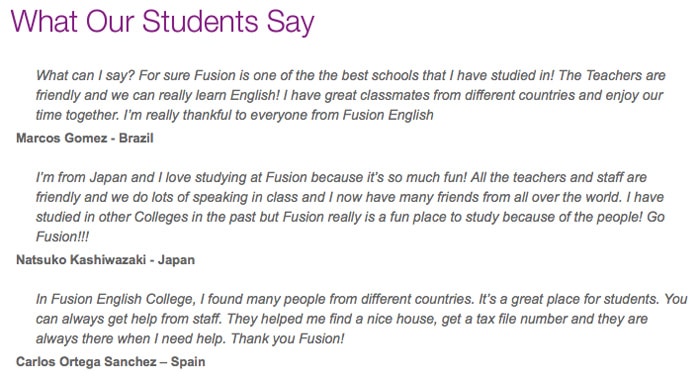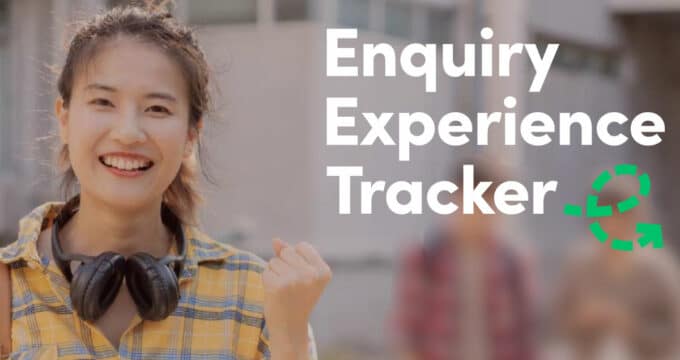Student testimonials are an untapped source of competitive advantage in recruitment marketing
Ask current students what convinced them to study with your education institution, and chances are it wasn’t a catchy tagline or the clever graphics employed in your logo. When selecting a school, students are looking for an experience that transforms their lives, that develops them into smarter and more successful people. They will be looking closely and using multiple sources for one thing:
The biggest likelihood that studying at School X will provide the experience they want and help them to achieve their goals.
For this, they will be checking out, as Noel-Levitz puts it, “… solid post-graduate and outcomes information to reinforce the strengths and benefits of academic offerings.” In other words, they want to see strong indicators that their considerable educational investment of time and resources will be well worth it.
And, one of the most effective ways for an institution to prove it is a worthy choice and a catalyst for success is the effective use of student testimonials.
Student testimonials move students beyond the institutional message – which is, on its own, a claim, no matter how elegant and well done – to more authentic, real-life evidence of the experience students have had at your institution and the extent to which it helped them to achieve their goals. Moreover, this movement is a movement toward conversion – toward the student being convinced enough to apply or enroll.
Today’s ICEF Monitor post will look at the importance of student testimonials and examples of good practice, including visuals and videos.

Testimonials are not being used to maximum effect
A 2012 Noel-Levitz study found that "only 38.8% of American four-year private institutions, 24.2% of four-year public institutions, and 17.2% of two-year public institutions said they provided information about outcomes and the value of earning a degree on their primary webpage or pages linked from that page.” Noel-Levitz goes on to note:
“While many institutions have become adept at crafting punchy marketing taglines for their web content, the concept of effectively employing multiple narratives in fortifying a school’s story has been chronically under-utilised.”
This idea of multiple narratives is the reason student testimonials are so integral to the overall marketing effort. Imagine anything expensive we might consider buying … let’s say it’s a new car. If we were looking to buy a new car, which of the following activities would we conduct to make our decision?
- Look for an attractive car
- Listen to the salesperson rave about the car
- Consult what industry magazines and consumer reports say about the car
- Talk to friends in the know about different makes of cars
- All of the above
The answer for virtually everyone would be, all of the above. This is what is meant by “multiple narratives", and the notion is just as applicable to any other high-involvement decision, including – perhaps especially – where to study. Expensive investments require more “narratives” than cheaper ones; they require more voices, sources of information, and indicators of successful outcomes. Add to that the investment of time students are making – which adds still more importance to the decision being the right one – and this becomes even truer. Royal Roads University’s Inspiring Connections campaign features alumni testimonials but also an opportunity for prospective students to connect directly with individual alumni via “LinkedIn-style networking”. In the video shown here, an alumna participates directly in a highly interactive testimonial display, which is well worth watching, especially for the shock factor.
Student testimonials trigger the emotional part of a buying decision
When students are considering competing institutions, they have a wealth of information to sort through, and it can be overwhelming. Student testimonials offer the student a simple story, allowing them to relax into the potential benefits of studying at an institution. Their story arc often goes like this, plus or minus one element:
- Student in testimonial has a challenge (e.g., wanting to change careers);
- Student is concerned, unsure (mirroring prospective student’s emotional state);
- Student decides to study at Institution X (makes the commitment);
- Student finds friends, learns a lot, has adventures, grows as person (prospective student imagines similar positive experiences);
- Student goes on to become important person in chosen career (proof investment was the right one, prospective student feels sense of calm and resolution).
Even more simply, the effect on a prospective student of a great testimonial might be summarised like this:
“I’m not so different, I want that success or that experience too, he/she did it, so can I.”

.
Commissioned testimonials as an antidote for bad press
When you commission testimonials and make them easy for people to find, it cuts down the impulse of prospective students who – lacking institution-enabled student testimonials – will go hunting for them wherever they can, from whatever sources, including places where disgruntled students post impulsive negative comments and stories about their experience. For example, just one of the comments we found when searching on the Internet for a certain college:
“Basically these schools are just student loan mills where they get you to sign for big student loans and then they do the minimum possible so you get an education. Just enough so you keep coming. Whether you get a job or default on the loan afterward is irrelevant to them.”
Bad press or bad reviews will be out there, and testimonials from happy students are a very good way to minimise their potential damage.
How to make student testimonials work in your marketing
We’ll now compile some of the best advice we’ve seen from various experts on how to make testimonials work for your institution. Here are five steps to gathering and presenting testimonials: 1. Look over the narratives (aka stories or messages) your institution is currently providing prospective students (i.e., via the website, brochures, etc.). Are there any testimonials? If there are, are they good, or are they boring, too polished (and thus not authentic-feeling), or out of date? See what should be replaced and see where there is room to add effective testimonials. 2. Establish student profiles and match testimonial selection to them. What kind of students are you trying to attract? Just one target market, or several with different needs, challenges, and profiles? Make a list of their profiles and understand that you’ll want to have testimonials from students that speak directly to them. For example, for a mature student audience, you’ll want mature students to provide testimonials about how your programmes changed their lives. 3. Create mechanisms to gather testimonials. Higher Education Marketing notes:
“One approach is to have current students and alumni respond to a series of interview questions about what they like about your programme, school, and location, including an open-ended section to encourage unexpected insights that might not otherwise be revealed.”
4. Decide what story elements your testimonials will feature. Higher Education Marketing provides these examples, assuming the students giving testimonials are current students:
- Student anecdotes about why they chose your school;
- Students’ future goals post-graduation;
- How your school will help them reach their goal;
- What made your school stand out;
- What their life path was before becoming a student at your school;
- Show the premises of your school.
If they were alumni, you would want your testimonials to include aspects of:
- How their lives changed;
- How they have achieved their goals.
5. Plan out your production and distribution strategy. Aim for some written testimonials and some video testimonials, and make sure the latter are optimised for mobile viewing and are ideally under five minutes. On the institutional website, aim to sprinkle testimonials through various sections – reserving consistent space for them on certain pages (e.g., one on the homepage, one on programme landing pages, one on a “conversion” page such as Contact or To Apply) and allotting a dedicated section just for them (e.g., Student Testimonials, What Students Say, In Students’ Own Words, etc.) The main thing is to place them thoughtfully.
Tips for compelling testimonials
The most important function of testimonials is that they add credibility and authenticity to the institutional message. At the same time, you will want to feature fairly articulate and successful students, so there is some balance to be struck. Here are some tips for achieving it:
- Choose students carefully for testimonials. They should be people with whom prospective students can relate to and aspire to emulate.
- Choose testimonials (from the many you will gather) that reinforce the messages and core advantages the institution is also communicating itself – as long as they do not sound too “salesy” or contrived.
- Have students talk about their individual, personal experiences rather than making bland statements about the institution. For example, “At first, I wasn’t sure I was going to make friends or even if I could speak up in class, but within two weeks I had joined three different activity clubs ” is more compelling from a student than, “The school makes it a priority to integrate students from different backgrounds by hiring capable counsellors and support staff.”
- Edit video and written testimonials to make sure the most compelling content shines and the boring bits and pauses are cut out.
- Encourage students to speak/write in specifics rather than in general terms. Why did this programme work for them – what was the most important reason it helped them achieve their goals?
- Don’t make students rave like product pitchmen (e.g., “This school is the best and there’s no way any other school could ever have given me what I got by studying here.”). Let them speak in their own words about what stands out to them as reasons they’re glad they studied there. And let them say something about the less positive aspects of their experience as long as it’s outweighed by the positives (e.g., “It was challenging sometimes for me to keep up with both my English language courses and my academic courses, but it was so worth it in the end.”)
- Present testimonials accompanied by rich student information. This adds to the credibility of the testimonial, like this example from Concordia University:

Here’s a nice example from Edinburgh Business School of a video testimonial geared to international students requiring a flexible programme. It features several students talking about their experience, and they speak articulately but not in an overly rehearsed way. Institutional benefits are highlighted, but one also gets a sense of students’ real personal lives and challenges. For more great examples of effective student testimonials, please see the slide deck below.
And for design tips on how to integrate testimonials into marketing collateral, click here:

Peer to peer sharing is here to stay
Consumers shopping for all sorts of products and services now look for peer reviews before they buy, especially when it comes to purchases they can’t see or touch, such as an educational programme in another country that they may not be able to visit before applying. The success of such sites as TripAdvisor, which now boasts more than 260 million unique monthly visitors, is proof of the demand for objective advice from peers, especially in the globalised marketplace for services. Given statistics like the Noel-Levitz ones we quoted at the start of this article – which suggest student testimonials are not yet being used enough – and the increasing competition across the board to recruit international students, it seems clear that obtaining more and better student testimonials (and presenting them effectively) should be a higher priority for many institutions.
















